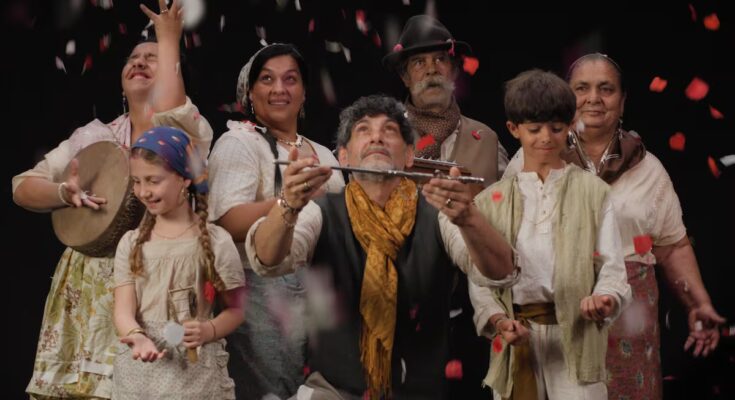“You don’t look like a gypsy.” It is the poisonous compliment that Eva Montoya (Madrid, 45 years old), screenwriter of the documentary film, has heard several times in her life. Pendaripen (history in Romani language) and the first woman belonging to this community to graduate from the School of Cinematography and Audiovisual of the Community of Madrid (ECAM). Pendaripenpresented yesterday Thursday at the European Film Festival in Seville and in theaters today, it is the first great audiovisual story of the history of the gypsy people: their six hundred years of presence in the Iberian peninsula, with the consequent six centuries of laws of rejection, persecution and identification.
The lack of social reproach in racism towards these people is one of the starting points Pendaripenwhich traces the history of exclusion and stigmas that still persist today. “A gypsy who does not fit a highly degraded stereotype is not seen as a gypsy.” “For better, I am not a gypsy; for worse, yes.” It is the rosary of declarations that are heard during the 90 minutes of filming of this film, which denounces “the normalization of racist demonstrations against us, which are much more accepted than in other minorities”, says Eva Montoya.
But to understand the construction of this unreasonable collective imagination we must retrace the gypsy pendaripen: a chronology of particular historical rigor that traces the persecution of this people in our territory from the 15th century to today, weaving the documentary from beginning to end, from the expulsion order of 1499 to some recent ones such as the one which prohibited the use of the Caló dialect, considered “criminal jargon” in the Franco dictatorship. Over the course of our history, up to 250 pragmatic laws, edicts and decrees have been enacted to persecute and exterminate this ethnic group.
There are particularly significant episodes, such as the prison sentences of Joanna I of Castile to put an end to the nomadic lifestyle of the gypsies “and force them to be a productive workforce for the kingdom”; the ban on Philip II from entering America; the gathering of gypsy children into orphanages in 1673, with the aim of “eradicating the bad seed” of their inheritance; or the one known as the Great Raid of 1749, an operation by the Marquis of Ensenada authorized by King Ferdinand VI which took place in a surprising and synchronized way throughout Spanish territory in the early hours of July 30 of that year and which ended with more than 9,000 arrested and interned in the so-called General Prison of Gypsies.
“From all this comes the distrust of our people towards the majority society, we have had to isolate ourselves to survive. It’s a miracle that we are here. Then there are those who say that we don’t want to integrate, that we like to live like this… but we have to protect ourselves. In six centuries of history what is truly real is that there is not a single space of safety for the Gypsy ethnic group. The volume of historical violence that we have received is like that of an abused woman, making us feel that it was our fault for wanting to preserve our culture and having learned to excuse the majority society,” reflects Eva Montoya with a lot of anger in her words.
It’s the pain he goes through Pendaripenbuilt starting from the internal perspective of the gypsy people themselves, the keystone on which its director, the Sevillian filmmaker Alfonso Sánchez (The world is ours, sow dreams…) carried out this project together with the producer Agus Jiménez: “Let them, the gypsies themselves, tell their own story”, a story which, although not belonging to this city, is not foreign to Sánchez: “I was born in a neighborhood that could also be called a ghetto, with a large gypsy population, and I have lived with them for as long as I can remember. For this reason it was clear to me that they had to be the ones to tell their story, because in addition the majority is not aware of it”, he states the director.
And here is the differential fact of this audiovisual work which, in addition to the screenplay by Eva Montoya, has the editing by Pablo Vega, director and gypsy activist; the experimental music of Quentin Gas and Los Zíngaros —Quentin Gas is the son of the great dancer Concha Vargas and nephew of the singer Esperanza Fernández, who also appears in the film—; and illustrations and animations by Sandra Carmona.
In front of the camera, historians, anthropologists, university professors, lawyers, artists and activists of this ethnic group who in all their declarations and reflections flee from folklore and clichés, denounce, reflect and rebel because, as its screenwriter summarizes it very well: “The image buries us”.
“Discovering the history of the gypsy people means measuring the architecture of racism”.
Lolita Flores
and inside worn out, the voice of the actress and singer Lolita, member of the Flores, one of the most iconic gypsy families in the country, who represents another of the pillars of this city: women and family. “It also happens in Palestine: all threatened societies have women as preservers of their people. Women who take the reins and take care of their families and their most fragile members when men are condemned, persecuted, murdered…”, reflects Eva Montoya, who recalls that gypsy women have been protagonists of all the social processes and revolts in the history of Spain.
And it is precisely that iconic woman, Lolita, who we perceive only through her voice, who finds the key to this work when we hear her say: “Discovering the history of the gypsy people is dimensionalising the architecture of racism”.



